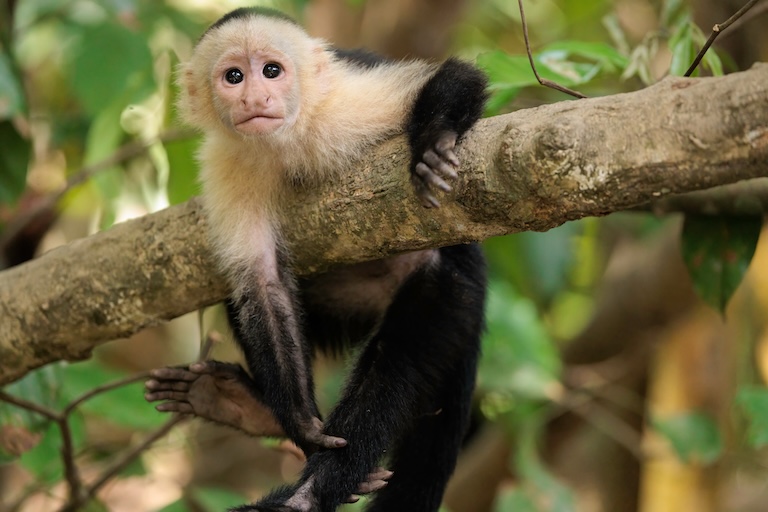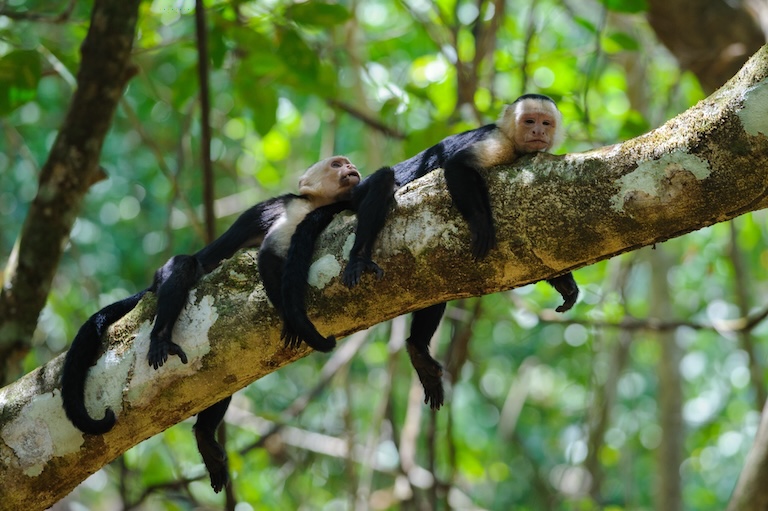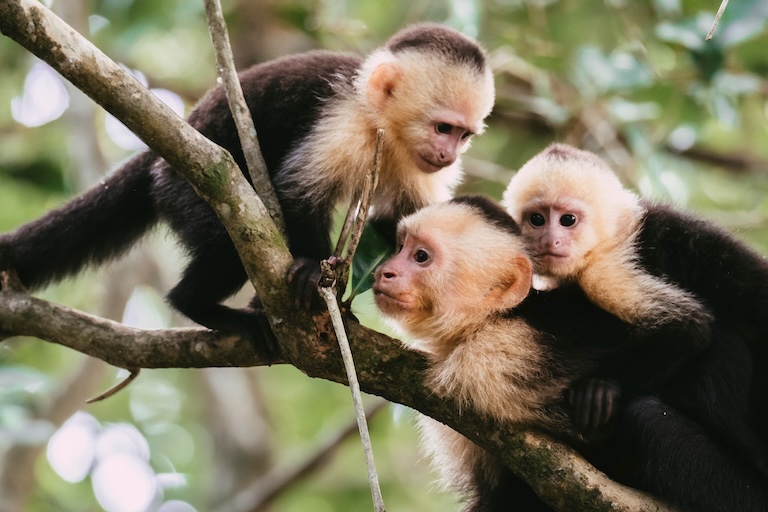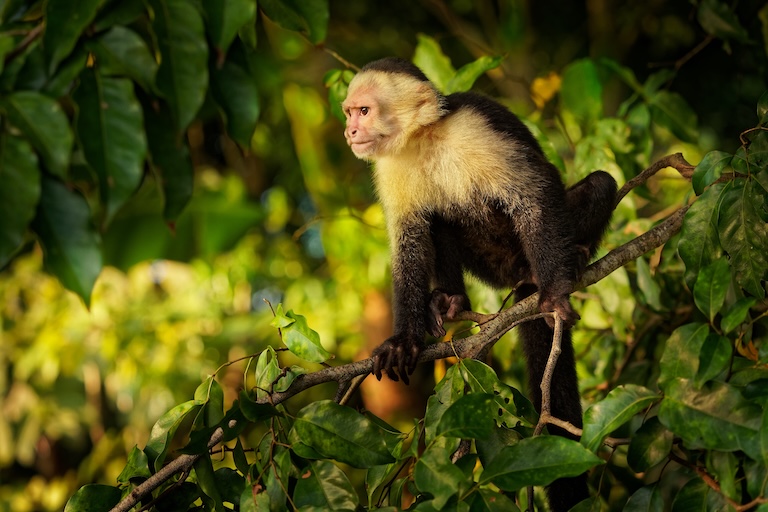White-faced Capuchin Profile
Etymology remains a fun and non-committal introduction to anything with a weird name, and today’s unrelated segue into a South American monkey species begins in Italy, where a coffee made with frothy milk reminded people of the colour of the hooded robes worn by an order of medieval monks.
These robes were said to have first been worn by Francis of Assisi, the homeless 12th-century friar who hoped to replace Christ in his teachings.
Fast forward to the 15th Century, and as Portuguese explorers were bringing European diseases to Central America, they discovered a coffee-coloured monkey whose top half reminded them of these very same robes. And so, the Capuchin monkey was born.

White-faced Capuchin Facts Overview
| Habitat: | Wide range of habitats: a variety of wet, dry, primary, and secondary forests, but prefer tropical evergreens and dry deciduous forests |
| Location: | Colombia and Panama |
| Lifespan: | Around 20+ years in the wild; 55 years in captivity |
| Size: | Around 45 cm (1.5 ft) long with a 50 cm (45 in) tail |
| Weight: | Up 3.9 kg (8 lb 10 oz) |
| Colour: | Brownish black, with white fur on their bellies, legs, and faces |
| Diet: | Omnivorous: ripe fruits, flowers, leaves, seeds, roots, insects, snails, spiders, and sometimes even young birds |
| Predators: | Wild cats, raptors, and snakes. |
| Top Speed: | Unknown |
| No. of Species: | 2 |
| Conservation Status: | Both are vulnerable |
Capuchins are a subfamily of New World monkeys, and are quite well known from the days of having trained monkeys in TV shows, live performances and adverts.
There are two genera, with the so-called “robust” capuchins in Sapajus and their “gracile” cousins in Cebus, which houses the majority of species.
The white-faced capuchins are two species that were once one, and given the history of this genus, this is still subject to change, but for now, they represent two of a whole bunch of interesting monkeys, known for their sociality, intelligence, strange breeding habits and significance to the ecology of the forests they inhabit.
Interesting White-faced Capuchin Facts
1. They’re Intelligent
Capuchins commonly rank highly in terms of cognition and are said to be easy to train. But in the wild, they exhibit some impressive smarts, too.
Tool usage is one metric that signifies intelligence to humans, and it is a capuchin species that showed us this trait is also present in monkeys, not just apes. These little monkeys will lug heavy stones from up to a mile away to use as cracking substrates for hardened seeds.
This behaviour is passed on to the young through watching and mimicking, and can take years to get right. They also crush up millipedes to use the toxins as mosquito repellent, which is a form of medicine. 1
In laboratory tests, capuchins have been taught the abstract concept of money and are said to be able to grasp the idea that there can be a medium of exchange between individuals with no inherent value of its own. This – particularly the lack of inherent value of money – is still lost on many humans, so the capuchins have done very well here. 2
Until recently, there was only one species of white-faced capuchin described, but this has now been changed.

2. There are 2 of them
Cebus imitator, the Panamanian white-faced capuchin, was, until around 2012, considered a subspecies of the Colombian white-faced monkey, Cebus capucinus.
While these two have now been proposed as separate species, there is still no strong consensus on this matter, though the two appear to have been separated around 2 million years ago.
One reason for the lack of consensus is that while the two were considered the same species, pretty much all the research done on them was conducted on the Panamanian populations.
So, there’s still a lot to learn about the Colombian side!
3. Females get along
What is known is that unlike many New World monkey species, females among the white-faced capuchins are rarely at each other’s throats.
Groups can be as many as 20 to 30 in number, and females exhibit long-term social bonds with one another – something that is more commonly found in Old World monkeys. Unlike Old World monkeys, however, capuchins have rather prehensile tails, which can be used to hold food and help as a fifth limb for navigating through the branches.
Capuchins are the only branch of this family with prehensile tails at all, which are more commonly seen in other New World monkey families. Unlike the common caricature though, these tails aren’t as strong and dextrous as to be used for hanging off. 3

4. They’re related
One reason for the strong bonds between females is that they’re usually half-sisters.
Alpha males get the monopoly on breeding rights, and this means that almost all the offspring in the group are his. Females of this species will rarely offer breeding to anyone else, though the alpha male’s daughter is typically off the menu for him so lower-ranking males do get some chances to breed when they become receptive.
This strict breeding strategy means that members of the group are usually much closer related to one another than is commonly found in other monkey species on the continent. 4
5. Males have it harder
So, alpha males may seem like they have it easy, but male capuchins are filling very difficult roles, regardless of their rank.
Males are typically dominant over females, but with this comes significant danger from other males.
Coalitions are the only way to ensure survival, and even these may not be enough. Relationships between males seem less affectionate and are always at risk of kicking off, and when fights occur, they are more than capable of killing one another.
Males found alone in the forest can be victims of group attacks, and all this inherent aggression in the system results in violence being the leading cause of death among male capuchins.
To make matters worse, male dispersal happens every four years or so, and this time when a lone male needs to join another troop is particularly dangerous. If a male does succeed in working his way into a group, he will kill the infants around to make the mothers receptive for mating again.
6. They’re forest guardians
Despite all this chaos and violence, these monkeys play a significant role in the health of the rainforest.
Capuchins are omnivorous, feeding on insects, birds’ eggs, frogs and even small mammals, but also getting through an enormous amount of fruit, as well as flowers and leaves.
Fruit makes up half or more of the animal’s diet, and can comprise of around 100 species of plants. Seeds are rarely eaten, so the monkeys’ feeding habits work to distribute the seeds of plants around the forest. 5
7. They’re threatened
Both species, despite being integral to the health of their ecosystem, are in decline and threatened.
Habitat loss is a major threat, as always, but increased amounts of hunting also contribute significantly to their decline.
As human agriculture expands into monkey territory, crop raiding incidents create human/wildlife conflict scenarios and the monkey are killed as pests. 6

White-faced Capuchin Fact-File Summary
Scientific Classification
| Kingdom: | Animalia |
| Phylum: | Chordata |
| Class: | Mammalia |
| Order: | Primates |
| Family: | Cebidae |
| Genus: | Cebus |
| Species Name: | C. imitator, C. capucinus |
Fact Sources & References
- Valderrama et al. (2000), “Seasonal Anointment with Millipedes in a Wild Primate: A Chemical Defense Against Insects? ”, ads.
- Chen et al. (2006), “How Basic Are Behavioral Biases? Evidencefrom Capuchin Monkey Trading Behavior”, Journal of Political Economy.
- Susan Perry(2012), “The Behavior of Wild White-Faced Capuchins: Demography, Life History, Social Relationships, and Communication”, Science Direct.
- Perry et al. (2008), “Kin-biased social behaviour in wild adult female white-faced capuchins, Cebus capucinus”, Science Direct.
- (2020), “Colombian White-throated Capuchin”, iucn Red List.
- (2020), “Colombian White-throated Capuchin”, iucn Red List.
